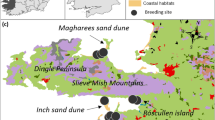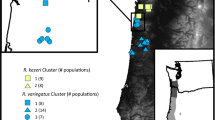Abstract
The tallgrass prairie of North America has undergone widespread habitat loss and fragmentation (<4% remains). The Flint Hills region of Kansas and Oklahoma is the largest tallgrass prairie remaining and therefore provides an opportunity to study the population genetic structure of grassland species in a relatively contiguous landscape and set a baseline for evaluating changes when the habitat is fragmented. We adopted a landscape genetics approach to identify how landscape structure affected dispersal, population genetic structure, and landscape connectivity of the Eastern Yellowbelly Racer (Coluber constrictor flaviventris) across a 13,500-km2 landscape in northeastern Kansas, USA. The racer population had high allelic diversity, high heterozygosity, and was maintaining migration-drift equilibrium. Autocorrelation between genetic and geographic distance revealed that racers exhibited restricted dispersal within 3 km, and isolation-by-distance. Significant isolation-by-distance occurred at broad regional scales (>100 km), but because of sufficient gene flow between locations, we were unable to define discrete subpopulations using Bayesian clustering analyses. Resistance distance, which considers the permeability of habitats, did not explain significant variation in genetic distance beyond Euclidean distance alone, suggesting that racers are not currently influenced by landscape composition. In northeastern Kansas, racers appear to be an abundant and continuously distributed snake that perceives the landscape as well connected with no cover type currently impeding snake dispersal or gene flow.



Similar content being viewed by others
References
Balkenhol N, Gugerli F, Cushman SA, Waits LP, Coulon A, Arntzen JW, Holderegger R, Wagner HH, Participants of the Landscape Genetics Research Agenda Workshop 2007 (2009) Identifying future research needs in landscape genetics: where to from here? Landscape Ecol 24:455–463
Banks SC, Lindenmayer DB, Ward SJ, Taylor AC (2005) The effects of habitat fragmentation via forestry plantation establishment on spatial genotypic structure in the small marsupial carnivore, Antechinus agilis. Mol Ecol 14:1667–1680
Briggs JM, Knapp AK, Brock BL (2005) An ecosystem in transition: causes and consequences of the conversion of mesic grassland to shrubland. Bioscience 55:243–254
Busby WH, Parmelee JR (1996) Historical changes in a herpetofaunal assemblage in the Flint Hills of Kansas. Am Midl Nat 135:81–91
Cagle NL (2008) Snake species distributions and temperate grasslands: a case study from the American tallgrass prairie. Biol Conserv 141:744–755
Castellano S, Balletto E (2002) Is the partial Mantel test inadequate? Evolution 56:1871–1873
Cavitt JF (2000) Fire and a tallgrass prairie reptile community: effects on relative abundance and seasonal activity. J Herpetol 34:12–20
Clark RW, Brown WS, Stechert R, Zamudio KR (2008) Integrating individual behaviour and landscape genetics: the population structure of timber rattlesnake hibernacula. Mol Ecol 17:719–730
Conant R, Collins JT (1998) A field guide to reptiles & amphibians of eastern and central North America. Houghton Mifflin, New York
Cushman SA, Landguth EL (2010) Spurious correlations and inference in landscape genetics. Mol Ecol 19:3592–3602
Cushman SA, McKelvey KS, Hayden J, Schwartz MK (2006) Gene flow in complex landscapes: testing multiple hypotheses with causal modeling. Am Nat 168:486–499
Dixon P (2003) Vegan, a package of R functions for community ecology. J Veg Sci 14:927–930
Double MC, Peakall R, Beck NR, Cockburn A (2005) Dispersal, philopatry, and infidelity: dissecting local genetic structure in superb fairy-wrens (Malurus cyaneus). Evolution 59:625–635
Egbert SL, Peterson DL, Stewart AM, Lauver CL, Blodgett CF, Price KP, Martinko EA (2001) The Kansas GAP land cover map: final report. Kansas Biological Survey Report 98
Epperson BK, Li T (1996) Measurement of genetic structure within populations using Moran’s spatial autocorrelation statistics. Proc Natl Acad Sci 93:10528–10532
Evanno G, Regnaut S, Goudet J (2005) Detecting the number of clusters of individuals using the software Structure: a simulation study. Mol Ecol 14:2611–2620
Fitch HS (1963) Natural history of the racer Coluber constrictor. Univ Kansas Publ Mus Nat Hist 15:351–468
Fitch HS (1999) Coluber constrictor. In: A Kansas snake community: composition and changes over 50 years. Krieger Publishing Company, Malabar, FL, pp 29–39
Gauffre B, Estoup A, Bretagnolle V, Cosson JF (2008) Spatial genetic structure of a small rodent in a heterogeneous landscape. Mol Ecol 17:4619–4629
Gibbs HL, Prior KA, Weatherhead PJ, Johnson G (1997) Genetic structure of populations of the threatened eastern massasauga rattlesnake, Sistrurus c. catenatus: evidence from microsatellite DNA markers. Mol Ecol 6:1123–1132
Greenwood PJ, Harvey PH (1982) The natal and breeding dispersal of birds. Annu Rev Ecol Syst 13:1–21
Holderegger R, Wagner HH (2006) A brief guide to landscape genetics. Landscape Ecol 21:793–796
Keogh JS, Webb JK, Shine R (2007) Spatial genetic analysis and long-term mark-recapture data demonstrate male-biased dispersal in a snake. Biol Lett 3:33–35
King AW, With KA (2002) Dispersal success on spatially structured landscapes: when do spatial pattern and dispersal behavior really matter? Ecol Model 147:23–39
Klug PE, Jackrel SL, With KA (2010) Linking snake habitat use to nest predation risk in grassland birds: the danger of shrub cover. Oecologia 162:803–813
Knapp AK, Seastedt TR (1998) Grasslands, Konza Prairie, and long-term ecological research. In: Knapp AK, Briggs JM, Hartnett DC, Collins SL (eds) Grassland dynamics: long-term ecological research in the tallgrass prairie. Oxford University Press, New York, pp 3–15
Koenig WD, Van Vuren D, Hooge PN (1996) Detectability, philopatry, and the distribution of dispersal distances in vertebrates. Trends Ecol Evol 11:514–517
Landguth EL, Cushman SA, Schwartz MK, McKelvey KS, Murphy M, Luikart G (2010) Quantifying the lag time to detect barriers in landscape genetics. Mol Ecol 19:4179–4191
Lougheed SC, Gibbs HL, Prior KA, Weatherhead PJ (1999) Hierarchical patterns of genetic population structure in black rat snakes (Elaphe obsoleta obsoleta) as revealed by microsatellite DNA analysis. Evolution 53:1995–2001
Luikart G, Sherwin WB, Steele BM, Allendorf FW (1998) Usefulness of molecular markers for detecting population bottlenecks via monitoring genetic change. Mol Ecol 7:963–974
Manel S, Schwartz MK, Luikart G, Taberlet P (2003) Landscape genetics: combining landscape ecology and population genetics. Trends Ecol Evol 18:189–197
Manier MK, Arnold SJ (2005) Population genetic analysis identifies source-sink dynamics for two sympatric garter snake species (Thamnophis elegans and Thamnophis sirtalis). Mol Ecol 14:3965–3976
Mantel N (1967) The detection of disease clustering and a generalized regression approach. Cancer Res 27:209–220
McRae BH, Beier P (2007) Circuit theory predicts gene flow in plant and animal populations. Proc Natl Acad Sci 104:19885–19890
McRae BH, Shah V (2009) Circuitscape user’s guide. online. The University of California, Santa Barbara. Available at: http://www.circuitscape.org
Molecular Ecology Resources Primer Development Consortium (2009) Permanent Genetic Resources added to Molecular Ecology Resources Database 1 May 2009–31 July 2009. Mol Ecol Resour 9:1460–1559
Oksanen J (2005) The VEGAN: Community Ecology Package. Version 1.6-7. Available at http://www.cran.r-project.org/
Parker WS, Plummer MV (2001) Population ecology. In: Seigel RA, Collins JT, Novak SS (eds) Snakes: ecology and evolutionary biology. The Blackburn Press, Caldwell, NJ, pp 253–301
Peakall R, Smouse PE (2006) Genalex 6: genetic analysis in Excel. Population genetic software for teaching and research. Mol Ecol Notes 6:288–295
Peakall R, Ruibal M, Lindenmayer DB (2003) Spatial autocorrelation analysis offers new insights into gene flow in the Australian bush rat, Rattus fuscipes. Evolution 57:1182–1195
Piry S, Luikart G, Cornuet JM (1999) Computer note. Bottleneck: a computer program for detecting recent reductions in the effective size using allele frequency data. J Hered 90:499–503
Pritchard JK, Stephens M, Donnelly P (2000) Inference of population structure using multilocus genotype data. Genetics 155:945–959
Pritchard JK, Wen X, Falush D (2009) Documentation for structure software: version 2.3. Universtiy of Chicago, Chicago, pp 1–37
Prosser MR, Gibbs HL, Weatherhead PJ (1999) Microgeographic population genetic structure in the northern water snake, Nerodia sipedon sipedon detected using microsatellite DNA loci. Mol Ecol 8:329–333
R Development Core Team (2005) R: a language and environment for statistical computing. Foundation for Statistical Computing, Vienna, Austria
Raufaste N, Rousset F (2001) Are partial Mantel tests adequate? Evolution 55:1703–1705
Raymond M, Rousset F (1995) Genepop (version 1.2): population genetics software for exact test and ecumenicism. J Hered 86:248–249
Rousset F (2000) Genetic differentiation between individuals. J Evolution Biol 13:58–62
Rousset F (2002) Partial Mantel tests: reply to Castellano and Balletto. Evolution 56:1874–1875
Schlötterer C (2000) Evolutionary dynamics of microsatellite DNA. Chromosoma 109:365–371
Schwartz MK, McKelvey KS (2009) Why sampling scheme matters: the effect of sampling scheme on landscape genetic results. Conserv Genet 10:441–452
Short Bull RA, Cushman SA, Mace R, Chilton T, Kendall K, Landguth EL, Schwartz MK, McKelvey K, Allendorf FW, Luikart G (in press) Why replication is important in landscape genetics: American black bear in the Rocky Mountains. Mol Ecol
Smouse PE, Peakall R (1999) Spatial autocorrelation analysis of individual multiallele and multilocus genetic structure. Heredity 82:561–573
Smouse PE, Long JC, Sokal RR (1986) Multiple regression and correlaiton extensions of the Mantel test of matrix correspondence. Syst Zool 35:627–632
Sokal RR, Oden NL (1978) Spatial autocorrelation in biology I. Methodology. Biol J Linn Soc 10:199–228
Sokal RR, Wartenberg DE (1983) A test of spatial autocorrelation analysis using an isolation-by-distance model. Genetics 105:219–237
Van Oosterhout C, Hutchinson WF, Wills DPM, Shipley P (2004) Microchecker: software for identifying and correcting genotyping errors in microsatellite data. Mol Ecol Notes 4:535–538
Waisanen PJ, Bliss NB (2002) Changes in population and agricultural land in conterminous United States counties, 1790–1997. Global Biogeochem Cycles 16:1137–1156
Wilgers DJ, Horne EA (2006) Effects of different burn regimes on tallgrass prairie herpetofaunal species diversity and community composition in the Flint Hills, Kansas. J Herpetol 40:73–84
Wilgers DJ, Horne EA (2007) Spatial variation in predation attempts on artificial snakes in a fire-disturbed tallgrass prairie. Southwest Nat 52:263–270
With KA, King AW (1999) Dispersal success on fractal landscapes: a consequence of lacunarity thresholds. Landscape Ecol 14:73–82
With KA, Gardner RH, Turner MG (1997) Landscape connectivity and population distributions in heterogeneous landscapes. Oikos 78:151–169
With KA, King AW, Jensen WE (2008) Remaining large grasslands may not be sufficient to prevent grassland bird declines. Biol Conserv 141:3152–3167
Wright S (1943) Isolation by distance. Genetics 28:114–138
Zellmer AJ, Knowles LL (2009) Disentangling the effects of historic vs. contemporary landscape structure on population genetic divergence. Mol Ecol 18:3593–3602
Acknowledgments
We thank numerous individuals, especially George Pisani of the Kansas Biological Survey and Curtis Schmidt of the Sternberg Museum of Natural History and, for tissue samples. Funding was provided by KPBS-LTER Program-NSF, Alan Kamb Grant for Research on Kansas Snakes, Busch Gardens and Seaworld Conservation Fund, Frances Peacock Scholarship for Native Bird Habitat-Garden Club of America, Sigma Xi Grants-in-aid of Research, and Kansas State University through University Small Research Grants, Biology Research & Instruction Enhancement Fund, Institute of Grassland Studies, and Ecological Genomics Institute. Animal protocols were carried out under permits from Kansas Department of Wildlife and Parks (SC-099-2007, SC-078-2008) and Kansas State University IACUC #2463.
Author information
Authors and Affiliations
Corresponding author
Rights and permissions
About this article
Cite this article
Klug, P.E., Wisely, S.M. & With, K.A. Population genetic structure and landscape connectivity of the Eastern Yellowbelly Racer (Coluber constrictor flaviventris) in the contiguous tallgrass prairie of northeastern Kansas, USA. Landscape Ecol 26, 281–294 (2011). https://doi.org/10.1007/s10980-010-9554-2
Received:
Accepted:
Published:
Issue Date:
DOI: https://doi.org/10.1007/s10980-010-9554-2




